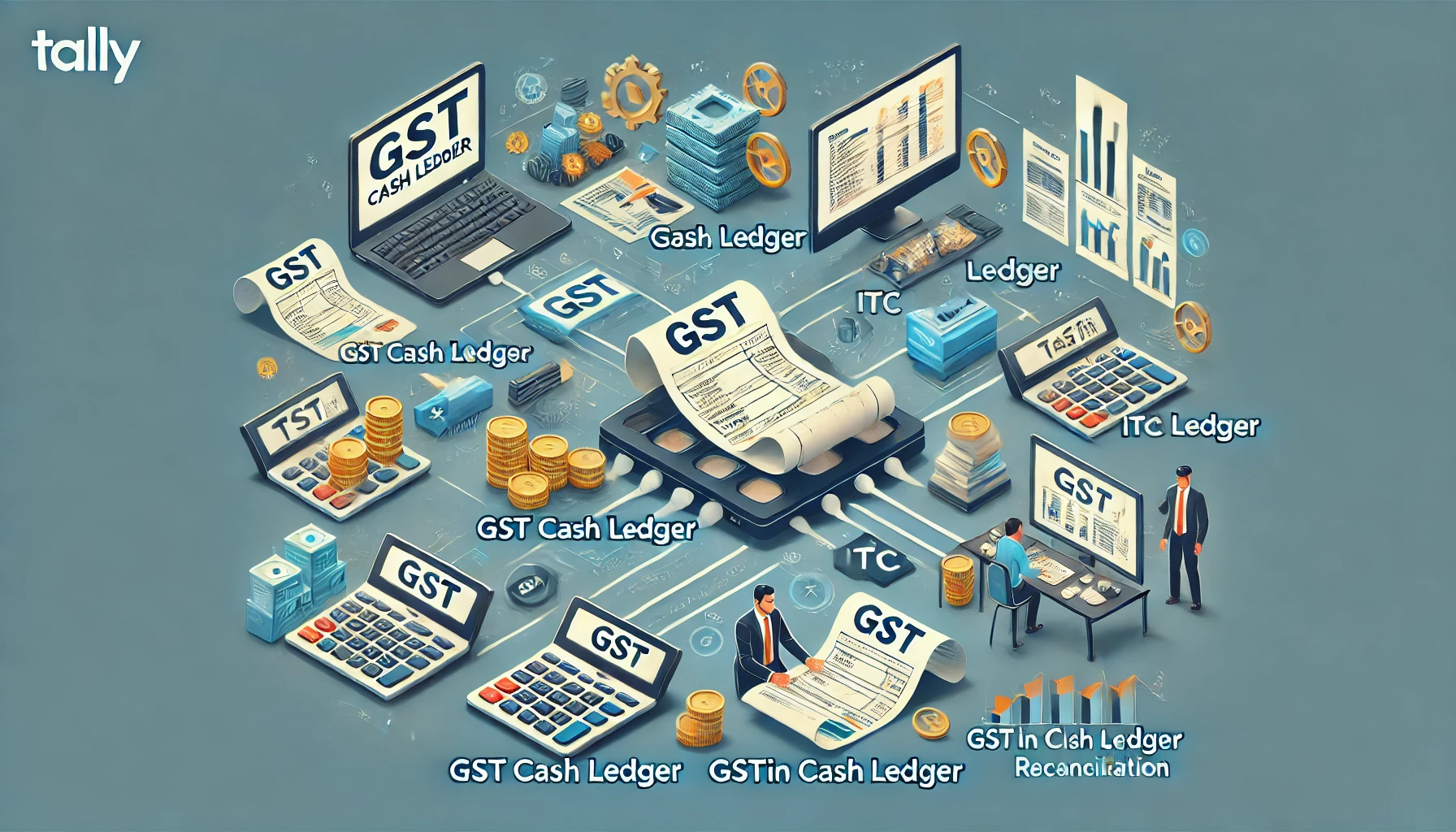As a business owner or accountant, managing GST entries accurately is crucial for compliance. In this guide, we will explain how to make GST entries in Tally and ensure your Cash Ledger and ITC Ledger are always synchronized with the GSTIN Cash Ledger and GSTIN ITC Ledger. By following these steps, you can easily reconcile your tax liabilities and credits for a smooth GST filing process.
1. Creating the Right Ledgers for GST in Tally
Before entering GST transactions, ensure that your Tally account has the correct ledgers. These ledgers help you track both your GST payable and GST Input Tax Credit (ITC) for accurate reconciliation:
- GST (Output) – CGST: Central GST liability
- GST (Output) – SGST: State GST liability
- GST (Output) – IGST: Integrated GST liability
- GST (Input) – CGST: Input Tax Credit for CGST
- GST (Input) – SGST: Input Tax Credit for SGST
- GST (Input) – IGST: Input Tax Credit for IGST
- Cash Ledger: For payments made via cash
- ITC Ledger: For tracking ITC utilization
Ensure these ledgers are created under the Duties & Taxes group in Tally.
2. Recording GST Sales and Purchases in Tally
Recording accurate sales and purchase transactions is essential for tax reconciliation. Let’s walk through the process for both:
Sales Entry (Intra-state or Inter-state)
For sales transactions, Tally automatically splits the GST output tax between CGST, SGST, or IGST, depending on whether the sale is intra-state or inter-state.
- Go to Gateway of Tally → Accounting Vouchers → F8: Sales
- Enter the Customer details and the Sales Ledger.
- Select the appropriate GST Output account (CGST/SGST/IGST).
- Enter the tax amount as per the GST rate.
- Save the entry to update your GST Payable liability.
Purchase Entry (Intra-state or Inter-state)
For purchases, you record Input Tax Credit (ITC) to offset your GST liabilities.
- Go to Gateway of Tally → Accounting Vouchers → F9: Purchase
- Select the Supplier and Purchase Ledger.
- Choose the appropriate GST Input account (CGST/SGST/IGST).
- Enter the tax amount based on the GST rate.
- Save the entry to update your ITC balance.
3. Managing GST Payments and Adjustments
When making GST payments, it’s important to accurately record payments made through your Cash Ledger and ITC Ledger. This ensures that both the GSTIN Cash Ledger and GSTIN ITC Ledger remain in sync.
Making GST Payment Using Cash and ITC Ledger (DRC-03)
If you are making voluntary payments through both Cash and ITC Ledgers, follow these steps:
- Go to Gateway of Tally → Accounting Vouchers → F5: Payment
- Enter the Bank or Cash Account for payment.
- Debit the GST Payable accounts (CGST/SGST/IGST).
- Credit the ITC Ledger to utilize Input Tax Credit for the payment.
- If there is a shortfall in ITC, make the payment via the Cash Ledger.
- Save the entry to ensure your Cash and ITC Ledgers are updated.
4. Reconciliation of Cash and ITC Ledgers
After recording your GST payments, it’s essential to reconcile your Cash Ledger and ITC Ledger with the corresponding GSTIN Cash Ledger and GSTIN ITC Ledger.
Here’s how you can do it:
- Go to Gateway of Tally → Display → Statutory Reports → GST → GSTR-3B to review your GST liability and payments.
- Compare the GST payable amounts with your payments recorded in the Cash Ledger.
- For ITC, go to Display → Statutory Reports → GST → GSTR-2A and ensure the ITC is aligned with your GSTIN ITC Ledger.
5. Ensuring Accurate GST Filing
Filing your GST returns on time is critical. To ensure accurate filing:
- Go to Gateway of Tally → Display → Statutory Reports → GST → GSTR-3B to verify your GST liability and ITC utilization.
- Check that both the GSTIN Cash Ledger and GSTIN ITC Ledger match the reported figures before filing your return.
Accurate reconciliation helps in filing your returns smoothly without discrepancies.
6. Tips for Maintaining Accurate GST Records in Tally
Here are some tips for ensuring your GST records are always up-to-date and accurate:
- Update regularly to keep your GST entries current and accurate.
- Reconcile periodically to avoid discrepancies during filing.
- Use GST Reports like GSTR-1, GSTR-2A, and GSTR-3B for tracking your GST filings.
- Ensure all payments are recorded promptly to prevent mismatches.

Hi, I’m Vishal
Founder of FinTaxExpert.in, with 7+ years of experience in taxation, audits, and corporate finance.
✍️ I’m passionate about writing and researching in the fields of taxation and finance.
📖 Learn more about us at FinTaxExpert.in.

